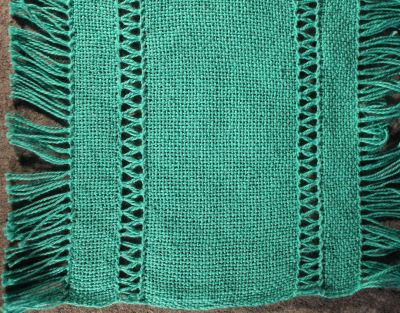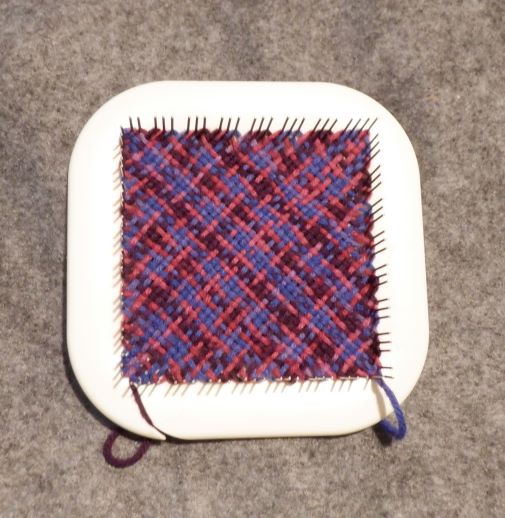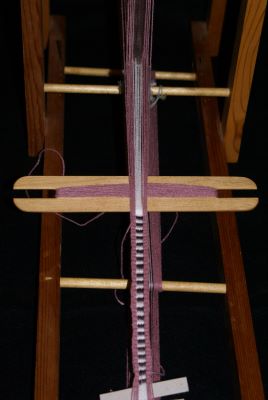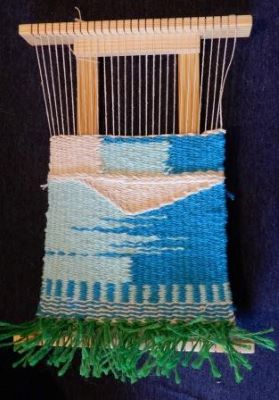Weaving Lectures & Demonstrations

Beyond Wool and Cotton If you work with fibers, knit, weave, etc., come to explore all the options you can use. You will be introduced to an abundance of fibers. Learn about animal fibers like yak and musk ox, plant fibers like ramie and lotus as well as regenerated manufactured fibers like rose, pearl and mint. Find out what the most expensive legal fiber is.

Two-Sided Overshot on Four Shafts This is a lecture with samples and a demonstration that illustrates how to have different color pattern wefts on each side of the cloth. The possibilities of having different patterns on each side of the cloth will also be discussed. Best-suited for intermediate weavers.
 Variations on Overshot By using different treadling sequences one can come up with dozens of patterns from one overshot threading. This lecture explores many of the possible patterns that can be woven on a traditional overshot threading.
Variations on Overshot By using different treadling sequences one can come up with dozens of patterns from one overshot threading. This lecture explores many of the possible patterns that can be woven on a traditional overshot threading.
Fabric Analysis Using paper and pencil one can examine a woven piece and figure out how the material was made, determining the threading and treadling. The use of a magnifying glass is helpful. The use of a computer will also be discussed.
Introduction to Drafting This is a hands-on lecture where participants will use paper and pencil to learn how to make a draw-down from a threading and treadling sequence.
Evolution of Weaving An historic overview of how man started weaving and how it has evolved into modern-day looms and industrial machinery. The importance of weaving in our society will also be looked at historically.
 Finishing Techniques for Weaving Once your woven piece is off of the loom it is time to finish it! See samples of what can be done on the loom and once your fabric is off of the loom. There are many rules or tricks of the trade that can be used to finish hand-wovens such as how to deal with fringe, decorate edges, join pieces and use beads.
Finishing Techniques for Weaving Once your woven piece is off of the loom it is time to finish it! See samples of what can be done on the loom and once your fabric is off of the loom. There are many rules or tricks of the trade that can be used to finish hand-wovens such as how to deal with fringe, decorate edges, join pieces and use beads.
 Crackle Weave Crackle Weave allows one to design using four blocks to create patterns and unlike Overshot, the blocks do not have to follow a prescribed order. Come see what Crackle has to offer! Geared for intermediate or advanced weavers.
Crackle Weave Crackle Weave allows one to design using four blocks to create patterns and unlike Overshot, the blocks do not have to follow a prescribed order. Come see what Crackle has to offer! Geared for intermediate or advanced weavers.
Weaving Workshops
Two-Sided Overshot on Four Shafts After the lecture and display of samples, participants will start weaving on their own loom, using different color pattern wefts on each side of the cloth. The possibilities of having different patterns on each side of the cloth will also be discussed. For intermediate weavers
 Ribbon Scarf Create a shimmering ribbon scarf with minimal equipment. This woven/braided scarf is finger woven on a board and can be made by anyone and have elegant results.
Ribbon Scarf Create a shimmering ribbon scarf with minimal equipment. This woven/braided scarf is finger woven on a board and can be made by anyone and have elegant results.
This is a technique taught by Makiko Tada. It is a direct derivative of Kumihimo on the
takadai.
 Weaving Diagonally on a Zoom Loom The Zoom Loom is a great little loom but let’s shake it up by weaving diagonally on it! Using a continuous yarn, you will learn how to weave a square diagonally. Beginner level
Weaving Diagonally on a Zoom Loom The Zoom Loom is a great little loom but let’s shake it up by weaving diagonally on it! Using a continuous yarn, you will learn how to weave a square diagonally. Beginner level
 Introduction to Inkle Loom Weaving Learn how to set up your inkle loom and start weaving! The basics of warping an inkle loom will be taught. Then tips on how to weave bands will be given and demonstrated. An inkle loom is designed for weaving narrow projects such as straps, belts, camera straps, trims, or bookmarks. Bring the inkle loom, heddles (or a strong string to make heddles) scissors, and a shuttle.
Introduction to Inkle Loom Weaving Learn how to set up your inkle loom and start weaving! The basics of warping an inkle loom will be taught. Then tips on how to weave bands will be given and demonstrated. An inkle loom is designed for weaving narrow projects such as straps, belts, camera straps, trims, or bookmarks. Bring the inkle loom, heddles (or a strong string to make heddles) scissors, and a shuttle.
![]() Band Weaving and Pick-Up Patterns Learn how to weave straps, belts, or bookmarks using a simple pick-up (Baltic style) technique. Threading instructions will be provided ahead of time. This is best done on an inkle loom.
Band Weaving and Pick-Up Patterns Learn how to weave straps, belts, or bookmarks using a simple pick-up (Baltic style) technique. Threading instructions will be provided ahead of time. This is best done on an inkle loom.
Variations of Overshot This is a workshop using the participant’s own overshot design (or a short pattern from a resource) and exploring the many possibilities that can be woven. It’s amazing to see the variety of designs one can achieve! Participants must know how to thread a loom, a 1 or 2 day workshop
 Basic Tapestry This workshop is designed for the beginner. It will teach how to set up a simple frame loom and change colors across the width of the loom for pictorial purposes. Various techniques will be taught for both two and three-dimensional effects. 1 to 3 day workshop.
Basic Tapestry This workshop is designed for the beginner. It will teach how to set up a simple frame loom and change colors across the width of the loom for pictorial purposes. Various techniques will be taught for both two and three-dimensional effects. 1 to 3 day workshop.
Finishing Techniques for Weaving Once your woven piece is off of the loom it is time to finish it! See samples of what can be done on the loom and once your fabric is off of the loom. There are many rules or tricks of the trade that can be used to finish hand-woven such as how to deal with fringe, decorate edges, join pieces and use beads. After examining the samples participants will practice several techniques.
Lectures and workshops can be created or tailored to an organization’s needs upon request if sufficient time is available.
